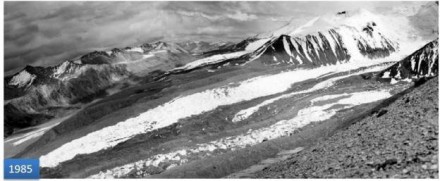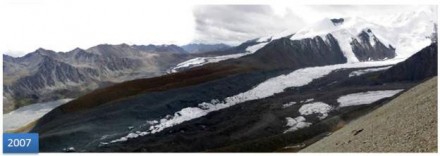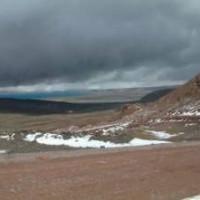We (at the Environment and Development Desk at DIIR, CTA) would like to alert all our readers about the impacts of Climate Change and Unplanned Urbanization on the Tibetan Plateau in series of short articles
Permafrost Degradation and Glacial Meltdown
Retreating glaciers and Permafrost Degradation
Many glaciers in Tibet are retreating due to the ongoing changes in the climatic variables over the plateau. The dramatic retreat of all the glaciers on the Tibetan Plateau in 1990’s is related to the continuous warming on the plateau since 1980s. In a more recent study about the sensitivity of cold glaciers, it was indicated that changes (rise) in the air temperature affects the glacier runoff more sensitively than other variables. The warmer air coupled with less snow and more rain would significantly increase the glacial runoff. In other words, less snow and more rain would mean decrease in the surface albedo (resulting to more solar heat absorption and more glacial runoff). Chinese scientist also predicts that 2/3rd of the present glacial cover will disappear by the end of this century. And most of all, to further increase the current worries, there has been no net accumulation of snow since 1950 over these mountains. According to Jane Qui (2008), 82% of the Tibetan Glaciers have already retreated in the past half century. In the past 40 years, Tibet’s glaciers have shrunk by 6,600 sq km (as of year 2006). It is estimated that they are currently melting at a rate of 7% per year (figures 1 a & b). Gou et al (2006), has even developed a tree-ring width chronology (from southern slope of Qiemuqu valley – the first major branch of the Yellow River) showing that trees in the area recorded glacier variations on the northeastern Tibetan Plateau. They also indicated that the glaciers on the edge of the mountain regions are more sensitive to climate change; as a result a dramatic retreat of Glaciers on the Eastern and Southern part of the plateau were observed.
Recent studies have shown that glacial melting and thawing of permafrost in the Tibetan Plateau will lead to a large scale release of GHGs (greenhouse gases) in the atmosphere and bringing further changes in the already warming climate. The permafrost layers and the seasonally frozen soils on the Tibetan Plateau are well preserved over a long time by low winter air temperatures. Its seasonal thawing and refreezing have also played a vital role in balancing the delicate alpine vegetations, until now. With the significant increase in the mean cold season average temperature, the permafrost layers and seasonally frozen grounds are slowly degrading leading to increased microbial decomposition of previously frozen organic carbon. Slope failures are often seen on the Tibetan Plateau due to permafrost degradation.
Permafrost degradation due to the warming climate has changed the regime of water retention and regulation by producing more runoff in areas of permafrost, leading to more evaporation. It has also prolonged the thawed period significantly leading to many interconnected ecological changes and technological worries. Locally, this degradation would result in the gradual desertification of grasslands, resulting to higher surface albedo and increased ground temperature.
The Tibetan Plateau rests on a seasonally frozen ground and permafrost layers. Almost 65 percent of its total area (2.5 Million Sq. Km) sits on permafrost (figures 2 a & b). With the warming climate and the positive feedbacks, these permafrost layers are in a process of continuous degradation.
In general, permafrost plays an important role in regulating water and has a significant influence on maintaining the plateau’s high-elevation ecosystems. Active layer of permafrost undergoes thawing in the summer, helping to drain away water into the wetlands and vast grasslands. Studies have indicated that the freeze and thaw cycles in the Earth’s surface intensify the heat and water exchange between the atmosphere and ground surface. This, in turn, affects the climate – as it does in East Asia. For instance, with the rise of 0.052°C/ y (air temperature), the permafrost area on the Tibetan Plateau will reduce about 195, 000 km2 (13%) and over 700,000 km2 (46%) within next 50 and 100 years respectively. In part, solar radiation is also responsible for the accelerating the thawing process, the areas below 5000 m are receiving radiation higher than all part of the china, about (250 – 360) J/ cm2. This will lead to the rise in the daily maximum temperature, at times reaching above 0 °C (even in cold winter months, Nov–Feb). Such instances lead to the frequent and strong thawing–freezing processes in the active layer.
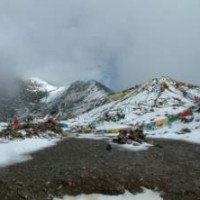
Besides the hydrological regimes, the permafrost degradation or thawing in many regions of Tibetan Plateau are affecting the surrounding vegetation as well as engineered structures. H. Jin et al (2000 & 2008) in their study, along the SLH (Siling Lhasa Highway) corridor have found that those areas covered by asphalt road surface showed significantly higher degradation ‘or’ depths of permafrost layer and higher mean annual ground temperature (MAGT). They also found that the heat accumulation under the asphalt road bases resulted in increased thaw depths too great to be frozen and consequently resulting in the transformation of vertically connected permafrost into disconnected phase. In other words, the road construction/ renovation have resulted to a faster degradation of the permafrost layer, compared to the natural state.
According to U.N. Environment Programme (UNEP), the frozen soil of the Tibetan plateau has warmed about 0.3°C over the past 30 years. Where human activity has disturbed the soil, such as during the construction of the railway, the rate is double, 0.6°C.
Recent studies showed that permafrost thawing in many regions of the Tibetan Plateau is influencing both hydrological regimes and vegetation, as well as engineered structures. According to Cheng and Wu (2007), the permafrost on the Tibetan Plateau is thawing more forceful than in Alaska. Such thawing of permafrost leads to the formation of thaw slumps, slope failure and in the process will inject lots of trapped carbons in the atmosphere, let alone for the lost of vegetations and carbon fixation.
The conditions of permafrost degradation, as observed by Jin et al (in 1999 or earlier) at the Huashixia Permafrost Station (about 70 km from Matoe; Ch: Maduo) was such that the active layers were oversaturated by water either from glacial runoff or rainfall during the thawing season (see box 1 for more detail).
It was observed that the increase in air temperature was more significant in cold season than in warm season leading to rise in the mean annual ground surface temperature (MAGST). Increase in the mean cold season air temperature plays a major role in changing the landscapes dominated by seasonally frozen grounds. In a separate study by H. Jin et al (2008), they indicated that the ground temperature at the shallow depths in transition and quasi-stable permafrost zone have been increasing noticeably, as a result leading to the shrinkage of permafrost boundaries. For instance, along the SLH (Siling Lhasa Highway/ Ch: QTH), the southern lower limit of permafrost have moved 10 km northward and the northern lower limit has moved 3 km southward. They also reported that the grounds temperature (at the depth of 6- 15 m) at Kunlun Pass have increased (02 – 04) °C in the past 15 years (1982 – 1997). Some other researchers have pointed out that approximately 30% of the SLH has to be repaired every year due to damage cause by frost action (see box 1 for more detail).
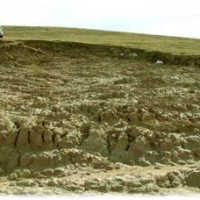
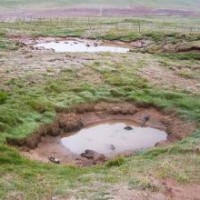
The maximum depth of the permafrost table under the asphalt road surface (near Kunlun Mountains) was recorded 5.2 m compared to 2.8 m under the normal state; and the MAGT ranging from (-1.0 to -0.2)°C under the asphalt road and (-2.5 to -3.5) for the normal state. In a separate study by Wei et al (2006), they found (in 2003) an arc shaped thaw slumping area near Fenghuaoshan Mountain measuring up to 73 m wide and 103 m long with the total volume failure about 10,000 m3 caused by the repairing of SLH. Their survey results showed that the thaw slum has been active for more than 10 years compared to the general thaw slumping life year of 3- 5 years and it will further remain active until the ice rich permafrost has completely disappeared.
Similar thawing of permafrost was observed in an excavation in the Kunlun Pass (elevation of 4715m in Amdo province) in September 1997. There, an oil pipeline, with a diameter of 168 mm (built in 1973 along the SLH), has induced a summer thaw depth of much higher magnitude (140–150 cm) compared to the nearby areas (90 cm). In consistent with that, due to the thaw settlement, the bridges and water conduits have also been damaged considerably. In a separate study in Amdo province, a permafrost drilling sample (at a depth of 3.5 m) taken in 1975 recorded the permafrost depth/ thickness to be 6.5 m. In July 1989, no frozen layer was detected in the same site, it had completely thawed.
Permafrost temperature at the source areas of the Drichu (Yangtze) and Machu (Yellow) Rivers rose by (0.11–0.14) °C between 1980 and 1998 and the active layer thickness increased at rates ranging from 2 to 10 cm/yr. The base of sporadically distributed permafrost in the source region of the Machu (Yellow) Rivers climbed around 50-70m in elevation between the 1970s and 1990s. The severe grassland degradation in the Nagchu area is also related to the degradation of permafrost. These changes in permafrost affect moisture contents in the soil, carbon exchange between the underground and the atmosphere. It was also found that the groundwater level at the head regions of Drichu (Yangtze) and Machu are dropping annually at the rate of 10 cm.
These changes in permafrost affect moisture contents in the soil, carbon exchange between the underground and the atmosphere. Such degradation also leads to the lowering of the water table, lake water levels and the shrinking of wetland and grazing grassland. This greatly affects farmers, for whom the growing season begins well before the rains of summer. The snow cover and frozen ground in winter melt sooner as climate change causes the plateau to warm sooner and stay unfrozen longer.
Data collected by Cheng and Wu (2007), indicated that there is a close relationship between the occurrence of sandstorms in China and the minimum freezing depth (of Permafrost) on the Tibetan Plateau. (The lesser the depth of permafrost, drier the top soil becomes and gets blown away in the form of sandstorms towards the windward side) The sands of the Tibetan Plateau can be transported by westerly winds to eastern China and even places as far away as the North Pacific. According to some other researchers, by 2040 (with the average increase in the mean annual ground temperature -MAGT by 0.4 to 0.5°C) most of the permafrost on the Tibetan Plateau will disappear based on the analyses of air temperature and fluctuation in the precipitation over East Asia.
We (EDD) argue that, the degradation of permafrost in the head regions of Machu and Drichu and the annual drop of water table (due to the climate change) has triggered a serious threat to the water security of China in the coming years. These natural factors have also led to the forceful removal of Tibetan nomads from their ancestral pasturelands.
Permafrost: The subsurface earth materials remaining below 0°C for two or more years
Active layer: The top layer of permafrost soil that thaws during the summer and freezes during winter. The temperature in the lower levels of the soil will remain more stable than that at the surface, where the influence of the ambient temperature is greatest. This means that, over many years, the influence of cooling in winter and heating in summer will decrease as depth increases
Box 1. The onset Permafrost degradation: Construction of SLH- Siling Lhasa Highway
The construction of Siling Lhasa Highway- SLH (Ch: Qinghai-Tibet Highway – QTH) about 530 km in the 1954 has led to the severe degradation of the permafrost soil, its vegetative mat and also its adjoining areas. The damaged vegetative mat has led to the loss of organic matter in the soil and the melting of the permafrost layer under the topsoil. This roadway construction initiated the onset of warming/thawing of the underlying permafrost and the destruction of the adjacent and nearby vegetation initiated similar warming/thawing processes in those areas. Based on the field survey (1990), thaw settlement along the SLH accounted for 83% of the road damage.
The next major degradation of permafrost (which resulted in far more short -term and long -term environmental damage than the initial SLH construction) took place during the road width expansion and reconstruction (placement of an asphalt pavement surface) from 1973- 1984’.
At Huashixia Permafrost Station (located at 70 km north of Maduo in Northeastern Tibetan Plateau) a 1 km-long ditch, which was excavated in 1988 for slope stream interception during the rehabilitation of the National Highway 214. However, the excavation resulted in the thawing of ice-rich permafrost along the highway and subsequently induced a retrogressive thermal slumping. The ditch had been enlarged to 50-350 cm in depth and 200-500 cm in width.
According to Wang and French, approximately 30% of the SLH has to be repaired every year due to damage cause by frost action. The current permafrost degradation (along the SLH) is mainly due to the surface disturbances [Conversion of Grassland to Cropland and vice versa; Golmud to Lhasa Oil Products Pipeline 1972–1977; 110-kV Transmission Line installed in 2005–2006; Construction and renovation of Siling Lhasa Highway- SLH 1954, 1973-84; Construction of Siling Lhasa Railway (GLR/ QTR) 2001–2006; The design of a new express highway from Siling to Lhasa is already under way with the beginning of construction anticipated within a few years.] over the past several decades, while the global warming may play a secondary role in speeding up the degradation.
References:
1.Abrahm Lustgarten, ‘Will Global Warming Melt the Permafrost Supporting the China-Tibet Railway?’, Article on ‘Scientific American’, 21 July 2009
2.Baolai Wang and Hugh M. French, Implications of Frost Heave for Patterned Ground, Tibet Plateau, Arctic and Alpine Research, Vol. 27, No. 4, 1995, pp. 337-344
3.Cheng Guodong and Wu Tonghua, Responses of permafrost to climate change and their environmental significance, Qinghai-Tibet Plateau, Journal of Geophysical Research, Vol. 112, 2007
4.Ding Yongjian, Liu Shiyin, Xie Changwei, Zhang Yong, Wang Jian. Yellow River at Risk, An Assessment of the Impacts of Climate Change on the Yellow River Source Region, Greenpeace, 2005
5.Environment and Development Desk, ‘TIBET, A Human Development and Environment Report’ (2008), EDD, DIIR, Central Tibetan Administration, Dharamsala, HP, India, ISBN 81-86627-68-5v
Evelyne Yohe and Laurie J. Schmidt, Riding the permafrost express, National Snow and Ice Data Center DAAC, http://nasadaacs.eos.nasa.gov/articles/2005/2005_permafrost.html
6.Gou Xiaohua, Chen Fahu, Yang Meixue, Jacoby Gordon, Peng Jianfeng and Zhang Yongxiang A comparison of tree-ring records and glacier variations over the past 700 years, northeastern Tibetan Plateau, Annals of Glaciology, Volume 43, Number 1, September 2006 , pp. 86-90
7.Hui-jun Jin, Qi-hao Yu, Shao-ling Wang and Lan-zhi Lü, Changes in permafrost environments along the Qinghai–Tibet engineering corridor induced by anthropogenic activities and climate warming, Cold Regions Science and Technology 53 (2008) 317–333.
8.Ikeda Atsushi, Sueyoshi Tetsuo, Matsuoka Norikazu, Ishii Takemasa and Uchida Youhei, Permafrost sounding (2003-2005) in the Source Area of the Yellow River, Northeastern Tibet’ Geographical Review of Japan, Vol 80, No 5 63 -75. 2007.
9.Jane Qiu, China: The third pole: Climate change is coming fast and furious to the Tibetan plateau, naturenews, Published online July 23, 2008.
10.Jin, H. J., Wu Jie, Cheng Guodong, Nakano Tomoko and Sun Guangyou, Methane emissions from wetlands on the Qinghai-Tibet Plateau, Chinese Science Bulletin Vol .44 No. 24 December 1999.
11.Jin, H. J., Shuxun Li, Guodong Cheng, Wang Shaoling and Xin Li, Permafrost and climatic change in China, Global and Planetary Change 26: (2000) 387–404.
12.Kishan Khoday, Climate Change and the Right to Development. Himalayan Glacial Melting and the Future of Development on the Tibetan Plateau, UNDP, May 7, 2007
13.Ma wei, Nui Fujun, Akagawa Satishi and Jin Dewu, Slope instability phenomena in permafrost regions of Qinghai-Tibetan Plateau, China, Landslides (2006) 3:260-264.
14.Meixue Yang, Shaoling Wang, Tandong Yao, Xiaohua Gou, Anxin Lu and Xuejun Guo, Desertification and its relationship with permafrost degradation in Qinghai-Xizang (Tibet) plateau, Cold Regions Science and Technology 39 (2004) 47– 53.
15.Nan Zhuotong, LI Shuxun and Cheng Guodong, Prediction of permafrost distribution on the Qinghai-Tibet Plateau in the next 50 and 100 years, State Key Laboratory of Frozen Soil Engineering, Cold and Arid Regions Environmental and Engineering Research Institute, Chinese Academy of Sciences, Lanzhou, China, 2003.
16.Norikazu Matsuoka, Atsushi Ikeda, Tetsuo Sueyoshi and Takemasa Ishii, Frozen ground monitoring (2004-2006) in the source area of the Yellow River, China, Tsukuba Geoenvironmental Sciences, Vol 2, pp 25 -30, Dec. 26, 2006.
17.Norikazu Matsuoka, Atsushi Ikeda, Tetsuo Sueyoshi and Takemasa Ishii, Monitoring Frozen Ground (2004-2005) at Madoi in the source area of the Yellow River, China, Tsukuba Geoenvironmental Sciences, Vol 1, pp 39-44, Dec. 26, 2005.
18.Norikazu Matsuoka, Atsushi Ikeda, Tetsuo Sueyoshi and Takemasa Ishii, Permafrost sounding (2003-2004) in the source area of the yellow River, China. Ann. Rep., Inst. GeoSci., Univ. Tsukuba, no. 30. pp. 30-38, Dec 24, 2004.
19.Tetsuo Sueyoshi, Atsushi Ikeda, Norikazu Matsuoka and Takemasa Ishii, Thermal History of Degrading Permafrost in the source Region of Yellow River, Northeastern Tibet. Ninth International Conference on Permafrost. June 29 – July 3, 2008, Alaska pp. 1733-1738.
20.Tingjun Zhang, T. Harry W. Baker, Guo-Dong Cheng and Qingbai Wu, The Qinghai–Tibet Railroad: A milestone project and its environmental impact, Cold Regions Science and Technology 53 (2008) 229–240.
21.United Nations Environment Programme, environment for development http://www.unep.org/climatechange/
22.Wu, C., C. Maurer, Y. Wang, S. Xue and D.L. Davis. 1999. Water Pollution and Human Health in China. Environmental Health Perspectives, vol. 107 (4): 251-256.
23.Wu, Douglas. 2000. China’s Quiet Property Rights Revolution. Cato Policy Report, vol. 22 (6).
24.Y. Feng, Q. Lu, T. Tokola, H. Liu and X. Wang, Assessment of grassland degradation in Guinan county, Qinghai province, China, in the past 30 years, Land Degradation and Development. (2008), DOI: 10.1002/ldr.
25.Zhou Jinxing, Yang Jun, Peng Gong, Constructing a green railway on the Tibet Plateau: Evaluating the effectiveness of mitigation measures, Transportation Research Part D 13 (2008) 369–376.

